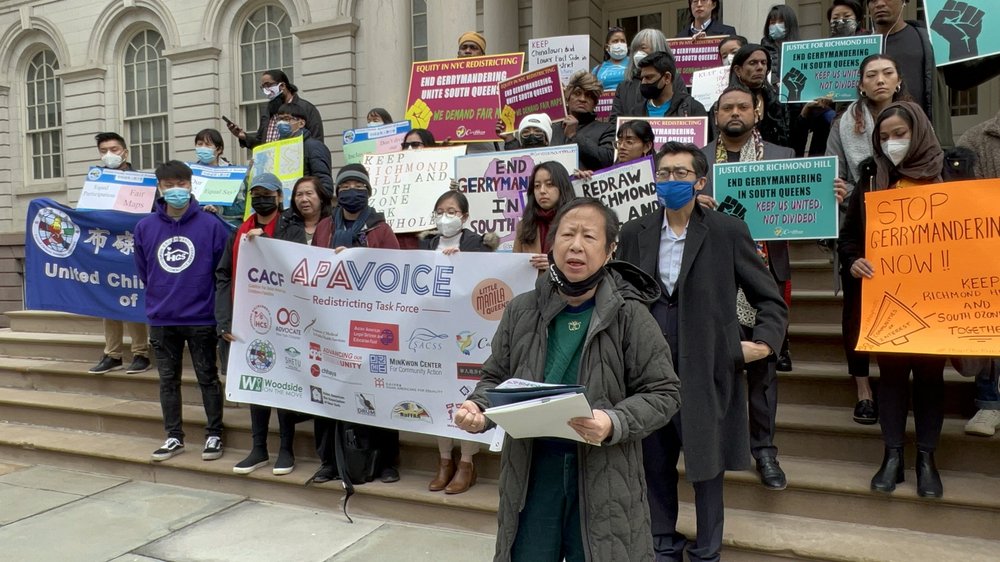Asian advocacy groups mobilize for more City Council representation as redistricting process begins
April 6, 2022, 10:08 a.m.
Asians were the fastest-growing population in the last decade, according to the U.S. Census

With a 33% jump in the city’s Asian population in the last decade, advocacy groups are increasingly looking to leverage those gains and play a major role in the City Council’s process to redraw representative districts, with an eye toward boosting Asian representation.
Twenty groups, part of the Asian American Pacific VOICE Redistricting Task Force, gathered outside City Hall on Tuesday to announce a series of workshops on the Council’s map-making process known as redistricting. Redistricting happens every 10 years following the release of the latest U.S. Census.
“We are here to demand that we have equal voice in all of the districts and that our voices are compacted, aren’t watered down so that we can maximize our participation in how to build the city back the right way,” said John Park, the executive director of the MinKwon Center, a Queens-based advocacy group that champions civic engagement within the Asian community.
The task force has scheduled a series of workshops for New Yorkers to learn about redistricting, on the following dates and at these locations:
- April 23rd, 1 to 3 p.m.: United Chinese Association of Brooklyn, 1787 Stillwell Avenue (Brooklyn)
- April 25th, 5 to 7 p.m.: Outdoors at the Murray Hill LIRR Station (Queens)
- April 27th, 6 to 8 p.m.: Chinatown YMCA, 100 Hester Street (Manhattan)
- April 30th, 2 to 4 p.m.: Amazing Grace, 6902 Roosevelt Avenue (Queens)
- May 11th, 6:30 p.m. to 9 p.m.: Liberty Palace, 130-11 Liberty Avenue, Queens
If we’re going to stay divided up like this it will be less likely for all the elected officials to interact closely [with] communities
Lori Huang, outreach health coordinator with the United Chinese Association of Brooklyn
For the task force, the results of the 2020 U.S. Census–which showed Asians to be the fastest-growing population in the city–indicated the potential for more political power within the Council. Figures show the city’s Asian population went from 1,028,119 in 2010 to 1,373,502 in 2020, a 33% increase. Asians now make up 15% of the population, compared to 12% in 2010.
Those numbers can translate into increased representation on the Council, advocates said, if the lines are reshaped to allow one single Asian community to fall under one Council district. As it stands, some Asian communities across the city are split into several Council districts, effectively diluting their power. That’s most notable in the neighborhood of Sunset Park, which is broken up into three districts.
Lori Huang, an outreach health coordinator with the United Chinese Association of Brooklyn, said packing the Asian community into one district can ensure the need for culturally sensitive bilingual services is met.
“If we’re going to stay divided up like this it will be less likely for all the elected officials to interact closely [with] communities,” Huang said in remarks.
A similar situation is playing out in the Queens neighborhood of Richmond Hill, a largely southeast Asian community that’s split into three Council districts. Mohamed Q. Amin, the executive director of the Caribbean Equality Project, an LGBTQ rights group, argued that the community’s needs have largely been ignored because of its divided power. He pointed to the height of the pandemic, when he said there was little access to testing.
“We deserve to be kept whole, we deserve to be united and not divided,” Amin said.
The New York City Council began the redistricting process last month after the body and Mayor Eric Adams appointed members to the New York City Redistricting Commission. Under the City Charter, the 15-member body–eight are appointed by the Council, and the rest by the mayor–are expected to hold a series of hearings seeking input from New Yorkers on the process.
Under the rules, the commission is expected to redraw the lines based on a set of criteria, including ensuring communities of interest are not divided. They must also ensure that each district are mostly reapportioned equally. After the commission draws the maps, they’re presented to the Council for a vote by the end of the year. With the new maps in place, current council members will once again have to run for their seats, despite being in the Council for one year.
Redistricting occurred on the state level last year, culminating with a redistricting commission failing to present agreed-upon maps to the state Legislature. Lawmakers took over the map-making process, developing their own congressional and legislative lines. The maps are now the subject of a lawsuit.